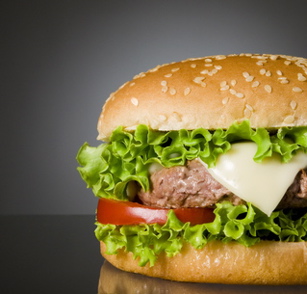 What’s wrong with this picture?
What’s wrong with this picture?
What’s more American than a hamburger? Apple pie? Baseball? Maybe. Yet hamburgers alone are an American icon at risk of becoming a symbol of the regulatory dsyfunction behind many food safety issues discussed on this website.
This Sunday, a New York Times Magazine article by Michael Moss highlighted the problems that put the safety of American hamburgers at risk. The article is sure to discourage many consumers from purchasing frozen hamburger patties, whether at a discount warehouse, retail grocer, or chain restaurant.
The article documented the result of USDA policy that allows self-regulation at both slaughterhouses and meat processing facilities (meat grinders). According to Mr. Moss’s investigative report, meat grinders rely on slaughterhouse suppliers to provide safe ingredients. Most grinders only test the finished product for contamination. And, in the case of Stephanie Smith, even that meager testing proved insufficient.
Requiring slaughterhouses and meat processors to conduct such tests is a regulation that was left on the cutting room floor, so to speak. According to a USDA Food Safety and Inspection Service assistant administrator quoted in the article, setting regulations includes balancing industry impact with public health. The contamination featured in the article resulted in a recall of 844,812 pounds of hamburger patties. That sounds like a major impact on industry to me.
The regulatory debacle behind the tainted hamburger patties consists of lax enforcement of regulations, dsyfunctional self-regulation and a lack of accountability. These flaws too often impose severe consequences on unsuspecting consumers.
In an industry where money talks, food safety regulations need sharper teeth that bite more often. Industry executives are free to set unreasonable production quotas. Such elevated quotas discourage safe and thorough slaughter practices.
Mr. Moss offered several opportunities for slaughterhouses and meat processing operations to defend their practices – very few took up the opportunity. Those who did speak up merely underscored the need for regulation by citing unwritten expectations between slaughterhouses and processors, and safety procedures that related more to risk management than to preventing contamination.
For me, the safest response to the flimsy regulatory climate in meat production is to demand more information before I buy any meat product. For my home, I ask the grocer or butcher the meat’s origin; to dine at a restaurant, I ask from where the meat came.
The transition is difficult. Enforcing this policy can ruin my hamburger craving (resulting in a veggie burger substitute), or it is a killjoy among friends; it entirely eliminates certain national chains from my dining options. Many Americans are not willing to make these sacrifices; many others do not feel they are financially able to make these choices.
The bottom line is this: Food safety needs to be a higher priority at slaughterhouses and meat processors. We may end up paying more for our meat, but we wouldn’t be nearly so afraid of it.
